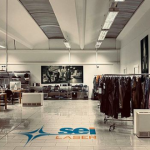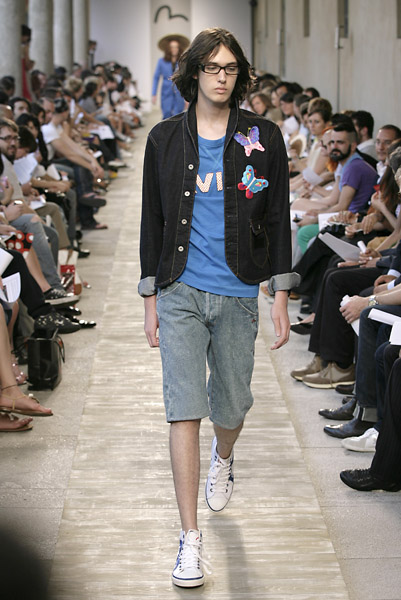This is a guest article by Dr. Wolfgang Schrott, University of Applied Sciences Hof on sustainable denim .
Denim, especially Blue Jeans, is meanwhile the biggest article segment in the textile industry. Besides many colors and shade variations, effects and cuts, which ongoing changes with the fashion, many brands have combined from the beginning of the denim fashion in the 60s a promotional message with their advertisement campaigns. From the “Young Rebels” (60s), “Western Style” (70s), “US lifestyle” (80s), “Italian Fashion” (90s) the today’s pre-dominate message is “leisurewear for young and old”. In combination with general lifestyle slogans many brands added also an ecological message as the environmental awareness is picking up in well-situated customer segments.
This eco-positioning of the brand was communicated with the customers via adverts and hang tags on the jeans and pointed out a singular aspect out of the total denim production chain. Therefore the today’s eco labelling does not cover the entire jeans production, although the message is closely related to the offered blue jeans in the point of sales.
Since the beginning of the millennium different detached eco messages could be seen on fairs and in the shops, covering environmental as well as social aspects of the denim production, but all failed in achieving a sustainable sales support.
This might be a proof that the – especially eco-sensitive – consumer is not as uninformed as many marketing and advertising experts do believe. On the other hand many eco-relevant production aspects are no longer actively promoted but are declared as standard in case of requesting for them. This is the case for child labor as well as or the avoidance of sandblasting as well as for the avoiding of banned products and processes (poisonous or hazardous products and processes, e.g. heavy metals, carcinogenic, mutagenic or toxic to fish and aqueous organisms products).
Organic Denim

Natural Jeans
In parallel to the organic-campaign several brands used the consumers demand for natural products to offer a natural jeans, being a Blue Jeans not only produced out of organic cotton but also dyed with natural indigo. Earlier evaluations by DyStar Textilfarben GmbH showed clearly, that natural indigo is – as well as organic cotton – not only not available to the market’s demand (therefore many natural indigo samples were identified as mixtures from natural and synthetic indigo) but also the eco balance of the natural indigo dyestuff production process in total is in disfavor compared with an environmental optimized indigo synthesis. Still today the indigo production process developed by BASF Aktiengesellschaft and the pre-reduced indigo (as 40% solution) established in the global denim market by DyStar Textilfarben GmbH are perceived as Best Available Technology (BAT). Besides the low yield of the natural indigo production in plants, a problem is caused by the insolubility of indigo in water. Therefore for the extraction of indigo from the natural plant big amounts of alkali is necessary, which regularly contains small amounts of heavy metals. After the dyeing process most of the heavy metal can be found on the Blue Jeans.
Dyeing Process
Also, for the synthetic indigo the production process and the purification
The electrochemical dyeing (ECD) process, which was proven in lab and pilot plant scale but is not yet established in the market place, replaces the chemical reducing agent hydrosulfite completely by electrons from the main. This technology reduces waste water pollution significantly and betters the ecological and economical situation in the dye house. Unfortunately this new technology was not supported by a labeling concept from retailers. Therefore the big denim producers were afraid to invest into the new machinery, needed for the ECD process.
This is also the situation in sulphur dyeing, especially with C.I. Sulphur Black 1, the most important dyestuff for black denim, which is also used for topping and bottoming of dark indigo blue dyeing and needs a lot of environmentally critical sulphur based reducing agents. Instead of using the electrochemical dyeing process and avoiding all type of chemical reducing agents, today in sulphur dyeing the environmentally non hesitating glucose is used as best option, which causes in the necessary quantities huge COD- and CSB values in the effluent.
After dyeing the cotton yarn and weaving the denim fabric is partly treated for special effects before cutting and sewing to garments. The blue denim fabric can be dyed in regular dyeing machines or printed or coated. The minimal application technologies are in this part of the production chain environmentally most friendly. A first production scale installation based on the patented foam application was realized by Gaston Systems at Orta Anadolu in Kayseri/Turkey.
Garment Treatments And Washing
Garments are mostly treated with physical and/or chemical methods to achieve special effects; especially for denim, the typically worn (vintage) look. Among the chemical methods the chlorine bleach (based on sodium hypochlorite) was widely used but disappeared – at least in Europe – due to the AOX problematic. Also special processes, e.g. the patented “moon wash”, based on a potassium permanganate bleach is no longer common. Achieving different, more cleaner, looks the peroxide, oxygen and ozone bleach is picking up in garment finish due to less environmental impact.
Instead of chemical methods and besides the established stone wash other mechanical processes (labor intensive) and laser application (investment) are increasing. The economically preferred sandblasting is banned by many brands since health problems at workers were detected.
The last production step in the denim chain is the final washing of the garments in industrial laundry machines. In this machines the garments can also be over-dyed with other dyestuffs (direct dyes, reactive dyes, pigments) or treated (finished) with other effect chemicals*) for special effects (e.g. soft hand, shine). As long as the used dyestuffs and effect chemicals are environmentally friendly, the most important impact in the laundries is the big quantity of water used and the high load of effluent produced there, because all process chemicals**) from the entire denim production chain are replaced from the raw jeans into the waste water. Therefore the knowledge about the previous production processes and an optimal wash-off process is essential for the environment, as well as an efficient waste water treatment plant.
On the latest BREAD & BUTTER fair (July 2011 in Berlin), one of the most important fairs for the denim brands, only few environmental aspects were promoted actively this time. Among them the saving of water in the laundries was predominant.
The US based denim giant Levis, which was ongoing promoting eco effects during the last years, presented now a “waterless” concept, achieving a
As well shown on BREAD & BUTTER by Japan Rags was a patented water-free denim finish “ Japan-RAGS ZERO ”, which – for the time being limited to six shades – is an ozone based finish process without of any water. This is hardly understandable due to the normally necessary wet of the substrate. On the other hand a totally water free garment finish means that all process chemicals**) from the denim production chain remains in the final blue jeans and can be removed firstly in the household wash by the consumer. Based on a total environmental evaluation of the Blue Jeans , this cannot be the optimum .
The eco-awareness meanwhile has arrived at the big denim finisher (laundries), as many of their activities show. The German Jeans maker Joker Jeans had already years ago heavily invested in an ozonisation of its waste water treatment system in Southern Germany.
Freshtex, Heilbronn/Germany , meanwhile producing in 10 countries as global player in the denim industry, has announced this year a company-wide recycling concept, which will be marketed and communicated by an own sustainability label. Also the Italian Martelli Group, one of the globally most innovative denim finisher, has presented in 2011 a new ecologically preferable finishing concept which supports a particular production step . The used products are removed after “having done the job” mostly by washing off into the waste water.
Recycling Denim
Another eco-relevant theme in the textile and especially in the denim industry is “Recycling”. In the past there could be found different approaches and realization by different producers and brands. The most
A ‘real’ denim recycling starting from worn out Blue Jeans as raw material in the denim production chain, as established in the paper industry for packing and newspaper, was evaluated only from few producers, e.g. Orta Anadolu in Kayseri/Turkey. The article segment is big enough to achieve a technical and economical interesting process, if several big denim brands would agree in a mutual concept. For this concept only the absence of non-recyclable raw materials is necessary. Then, a pure cotton Blue Jeans could be liberated from all metal parts and labels and shreddered. The shreddered denim, mainly cellulosic material, could be similarly deinked as realized in the paper industry for another origin of cellulosic material. The so achieved recycling cotton could as is or as mix with fresh cotton used again as raw material in the denim production chain. This “real denim recycling” could become more attractive for the consumer by launching a pledge (for a recyclable jeans). Additionally such an “R-Jeans” would generate an attractive marketing concept, especially for the growing, environmental-conscious customers.
Which ideas remain to a technical orientated visitor of the last denim fashion fairs?
Nothing really new – more labels, more action, hopefully in the right direction!
What is the right direction regarding an environmental friendly denim production ?
Surely a sustainable denim production has in terms of the eco-efficiency analysis to show an optimum for the environment as well as to be commercial feasible. The development and comparison of sustainable denim production processes therefore should be measured by the eco-efficiency analysis procedure.
In principle, innovative and eco-friendly products and processes should be economically attractive if the cost for waste water cleaning and other environmental protection initiatives are calculated realistically. Most important for all ecological evaluations and comparisons of Blue Denim production concepts is the aspect, that the entire denim production chain is compared, because many process steps and products used in it have implementations on the following production step(s). Therefore only a total process comparison can offer a real comparison.
This total process approach was firstly presented 2006 by DyStar Textilfarben GmbH in its econfidence® denim concept. Unfortunately, this concept could not fully realized in the denim industry due to the insolvency of DyStar Textilfarben GmbH. Examples out of the concept for a sustainable denim production are: Electrochemical dyeing (ECD) on rope and slasher dyeing ranges, Minimal Application Processes in the denim production, electrochemical dyeing (ECD) and especially electrochemical bleaching (ECB) in garment dyeing/finishing machines (laundry machines), combination processes and recycling concepts in denim laundries and garment finishing mills, eco-efficiency evaluation of denim processes (analogously to econfidence® Denim).
The today’s Best Available Technology (BAT) in denim production as well as the future denim production trends are summarized in a separate publication of the author (in preparation). The result out of this publication can be summarized as follows:
Summary
The sustainable denim production in future will be always a process, involving all single steps of the entire denim production chain. Hereby, the optimum comes from harmonizing the used products, machinery equipment and process parameters to an optimum. In this process of development it would be very helpful, if the retailers (global jeans brands) could not only implement a global jeans recycling concept but also orientate the future eco-labeling on BAT parameters. Minimizing environmental impact and cost in the denim production will mean the use of minimal resources, chemicals, energy and water as well as minimal CO2 emission.
Notes:
*) effect chemicals: products, e.g. dyestuffs, optical brighteners, softeners, which causes a special effect on the textile material and keeps on the garment during wearing.
**) process chemicals: products, e.g. reducing agents dispersing agents, detergents which supports a particular production step and which are removed after “having done the job” mostly by washing off into the waste water.




